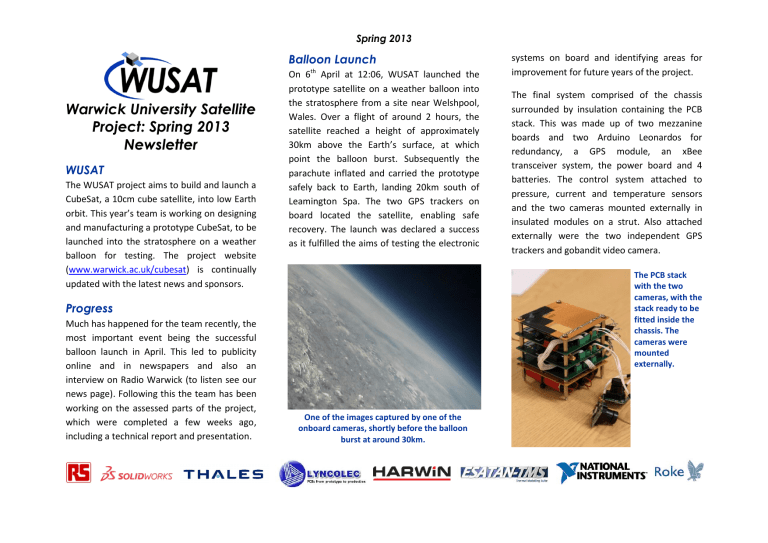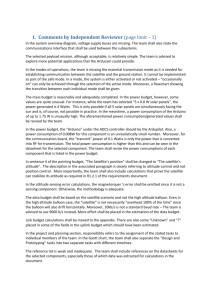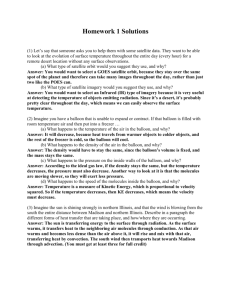Balloon Launch

Warwick University Satellite
Project: Spring 2013
Newsletter
WUSAT
The WUSAT project aims to build and launch a
CubeSat, a 10cm cube satellite, into low Earth orbit. This year’s team is working on designing and manufacturing a prototype CubeSat, to be launched into the stratosphere on a weather balloon for testing. The project website
( www.warwick.ac.uk/cubesat ) is continually updated with the latest news and sponsors.
Progress
Much has happened for the team recently, the most important event being the successful balloon launch in April. This led to publicity online and in newspapers and also an interview on Radio Warwick (to listen see our news page). Following this the team has been working on the assessed parts of the project, which were completed a few weeks ago, including a technical report and presentation.
Spring 2013
Balloon Launch
On 6 th
April at 12:06, WUSAT launched the prototype satellite on a weather balloon into the stratosphere from a site near Welshpool,
Wales. Over a flight of around 2 hours, the satellite reached a height of approximately
30km above the Earth’s surface, at which point the balloon burst. Subsequently the parachute inflated and carried the prototype safely back to Earth, landing 20km south of
Leamington Spa. The two GPS trackers on board located the satellite, enabling safe recovery. The launch was declared a success as it fulfilled the aims of testing the electronic
One of the images captured by one of the onboard cameras, shortly before the balloon burst at around 30km. systems on board and identifying areas for improvement for future years of the project.
The final system comprised of the chassis surrounded by insulation containing the PCB stack. This was made up of two mezzanine boards and two Arduino Leonardos for redundancy, a GPS module, an xBee transceiver system, the power board and 4 batteries. The control system attached to pressure, current and temperature sensors and the two cameras mounted externally in insulated modules on a strut. Also attached externally were the two independent GPS trackers and gobandit video camera.
The PCB stack with the two cameras, with the stack ready to be fitted inside the chassis. The cameras were mounted externally.
Electronics
Over the duration of the flight, the power and control system functioned well, recording pictures and data throughout the flight. The photos were stored and successfully recovered from one SD card whilst the other became permanently corrupted, leading to the loss of sensor data. The cause is unknown but the effect of cosmic radiation may need to be considered by future teams.
The communications system maintained a link with the base station throughout the flight, but many data packets were lost throughout the flight, due to the transmitted data rate defaulting to a high value causing a decrease in range. An improvement would be for the control system to include a more robust error checking mechanism. This was not realised this year due to the limited code size of the Arduino Leonardo system.
The prototype satellite being launched.
Spring 2013
The final assembly of the chassis and insulation, attached to the antenna and the strut carrying the two camera modules and gobandit video camera.
Mechanical
The chassis and thermal housing performed well, with the final chassis design conforming to the specification of weight minimisation and easy assembly and disassembly. It was built to withstand at least 10 m/s, specified because of the expected descent rate of 5 m/s with a factor of safety of 2. Some of the data collected suggests that the satellite may have descended at 12 m/s. While the accuracy of this reading is unknown, if true it suggests that the parachute did not open fully, which any further balloon launches would need to address. On this occasion the satellite landed in a bush, rendering no damage.
The thermal system, comprising of a polystyrene casing for the satellite and several small independent heaters, kept the satellite working throughout the flight despite the extreme temperatures, expected to reach as low as -55 ° C. The gobandit video camera was not insulated and so stopped working halfway through the descent, capturing take-off, ascent and balloon burst fully.
Industrial Links
In early May, the WUSAT team held a presentation open for sponsors to attend, followed by a lunch kindly provided by
Harwin. This allowed the attending sponsors to see the progress of the project this year and discuss this and the aims for next year with the team. It was a success with Lyncolec,
ITP Engines (ESATAN) and National
Instruments attending.
The team together after the presentation and lunch.




